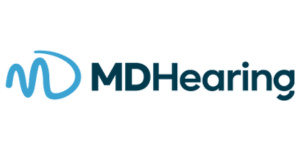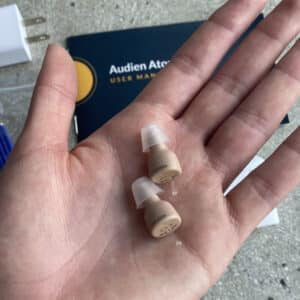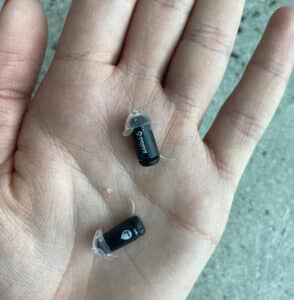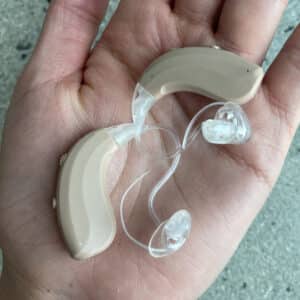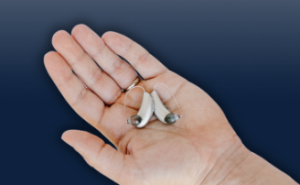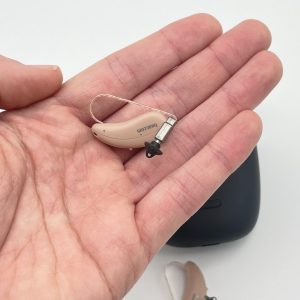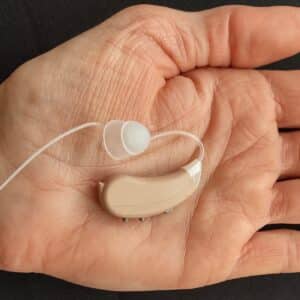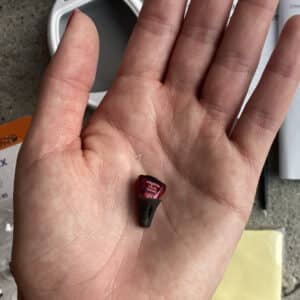Jabra Enhance earns “Best Overall” for the company’s combination of quality, over-the-counter devices and a commitment to ongoing customer service that includes support from an audiology team (specialists trained to treat hearing loss) if you purchase the premium package. All this together makes Jabra Enhance one of the best OTC hearing aids on the market.
10 Best Hearing Aids of January 2025: Expert Reviewed
Whether you’re having dinner with friends or watching television at home, hearing loss can get in the way of your quality time, disrupt your ability to communicate and gather information effectively, and lessen your confidence in social settings. But the right hearing aid can enhance your hearing and even protect your brain from cognitive decline so you feel more comfortable and confident in all areas of your life. Our team compared the best hearing aids for 2025 based on features, pricing, and customer care to help you make the right decision for your needs.
For our recommendations on the most budget-friendly hearing aids of the year, visit our list of the most affordable hearing aids we researched and tested.
A quick look at the best hearing aids of 2025
- Jabra Enhance: Best Overall
- Audien: Most Affordable
- Eargo: Best Invisible Fit
- MDHearing: Most Feature Options
- Audicus: Best for Post-Purchase Care
- hear.com: Most Personalized Solution
- Lexie: Most User-Friendly
- Phonak: Best Prescription
- Signia: Most Natural Sound
- ReSound: Best Rechargeable
How we research and review hearing aids

We only recommend hearing devices that we think will have a positive impact for our readers, so we began our testing process by reviewing hearing aid research. We also consulted with audiologists and geriatric care experts to better understand the research, the needs of people with hearing loss, and the hearing aid brands and models on the market.
We read thousands of hearing aid reviews on trusted third-party sites such as Better Business Bureau (BBB) and Trustpilot to understand customers’ experiences and where they think hearing aids are falling short. Next, we conducted a survey to discover what people love about their hearing aids, what features they use, and what their biggest challenges are.
We focused on brands that:
- Are widely available
- Have a range of prices
- Treat different types of hearing loss
- Offer a variety of features for different hearing concerns
Any time we recommend a hearing aid brand, we have our selections medically reviewed by an audiologist to examine the company, find the best model, and ensure every hearing aid on our list is appropriate for our readers’ needs.

We are constantly testing and researching hearing aids and evaluating the newest technology. Every month, we look at the latest hearing aids to ensure you receive up-to-date information. Check back regularly to discover our latest updates.
Read more about our hearing aids review methodology.
The best hearing aid brands, as of January 2025
| Battery | Rechargeable | Rechargeable | Rechargeable | Rechargeable | Rechargeable with disposable options | Rechargeable | Rechargeable and disposable | Rechargeable | Disposable | Rechargeable and disposable |
| Bluetooth | Yes | No | Yes for adjustments only, no streaming |
Yes for adjustments only, no streaming |
Yes (except the Mini) | Yes | Yes adjustments only, no streaming; iPhone call streaming through B2 model only |
Yes | No | Yes |
| Warranty | 3 years (Enhance Select 50R, 300, and 500) | 1 year | 1–2 years | 1 year | 2 years | 1–3 years | 1 year | Depends on retailer | 2 years | Depends on retailer |
| Financing | Yes | No | Yes | Yes | Yes | Yes | Yes | Depends on retailer | Depends on retailer | Depends on retailer |
Best hearing aids of 2025
Our expert take on Jabra
Jabra Enhance focuses on giving customers full access to its audiology care team to ensure help is available. As a Jabra Enhance customer, you’ll get personalized, professional expertise—with no in-person visits to an office or hearing center—for a low price compared to other OTC hearing aids. Not every OTC hearing aid company has an audiology care team on staff for consultations.
Jabra Enhance offers an online hearing screening and a pre-purchase video consultation with a member of the audiology care team. The company’s devices can also be paired with a smartphone app that allows you to adjust the settings or volume from your phone.
If you choose the Premium package for $200 more when buying a pair of Jabra hearing aids, you’ll get remote support from the audiology team to set up the app and your hearing aids. You can also receive audiology team consultations for up to three years if you need adjustments. Customers who choose the Basic package will get their Jabra hearing aids programmed for their hearing loss profile before the devices are shipped to them, but ongoing audiology support is not included.
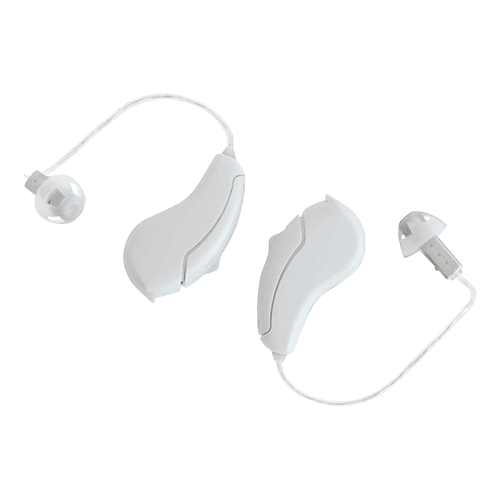
A pair of rechargeable Enhance Select 50R hearing aids cost $995 (basic package), about 40% less than the average $3,000 price tag for similar high-tech aids purchased at an audiology clinic. A pair of rechargeable Enhance Select 300 costs $1,495–$1,695 (basic versus premium package), though the company offers financing options that allow you to pay as little as $49–$55 per month for this device.
Jabra Enhance offers a prescription hearing aid called the Pro 20, which is available through Costco Hearing. It is available in different variants, including a receive-in-ear device, a behind-the-ear device, and a completely-in-the-canal device.
Over-the-counter Jabra Enhance devices include the Jabra Enhance 300 and Jabra Enhance 500. The Jabra Enhance 300 is priced between $1,495 and $1,795. It has hands-free calling and a “start delay” that helps prevent whistling when the devices are inserted.
Jabra Enhance also has a newer rechargeable model called the Enhance Select 500. At $1,795 per pair for the basic package ($58 per month with financing) or $1,995 per pair for the premium package ($65 per month with financing), the Enhance Select 500 is the most expensive option. But it’s also smaller than the Select 300 and offers the company’s newest technology, including Bluetooth LE and Auracast streaming.
Jabra says the 500 provides greater depth of sound than the 300, better speech understanding in noisy settings, and minimal disruption from repetitive background sounds (like dishes clattering or dogs barking).
For a high-quality OTC hearing aid with knowledgeable remote audiology support, Jabra Enhance Select is our top choice.
Read our Jabra Enhance review for more information.
Our expert take on Audien
The Atom Pro has a collection of features that help it punch well above its weight class, including enhanced feedback cancellation and advanced sound processing. It is a small, in-the-canal (ITC) hearing aid with a rechargeable battery that lasts up to 24 hours (after charging for four to six hours) and can be charged wirelessly in the hearing aid case. The Atom Pro also features Audien’s newest sound processing technology, which the company says cuts down on feedback and the whistling noise that can be common in hearing aids.
Along with the low price point, Audien hearing aids are differentiated by an unlimited protection plan, which is a step above the standard one-year warranty. For $4 per month, you can enroll in the plan, which covers broken, lost, and damaged devices. This warranty will give you a replacement pair of Atom Pro hearing aids for $34.
With the Atom Pro’s competitive low price comes less functionality and fewer features. For starters, Audien doesn’t offer audiologist support or remote adjustments. That means you’ll be on your own for any attempts to adjust your devices or troubleshoot issues, although the company does offer a limited number of articles and videos to help resolve common problems on its support page. In addition, none of Audien’s devices can be customized for your particular hearing needs, and the company offers no smartphone app—both of which are standard features of the rest of the hearing aids on this list.
If you’re comfortable sacrificing function and features in exchange for getting one of the most affordable hearing aids on the market, the Audien Atom Pro may be a good choice. But if you’re a first-time hearing aid buyer or would prefer more support, we recommend choosing another hearing aid with options for remote adjustments or audiologist support.
Read our Audien review for more information.
Our expert take on Eargo
The Eargo 7 features an improved Sound Adjust+ with Clarity Mode, which can automatically adjust the hearing aids’ sound profile to your surroundings for a clearer listening experience in both loud and quiet environments. The Eargo 6 has a similar Sound Adjust feature, but it functions best in quiet environments. While most Eargo hearing aids come with a one-year warranty, the Eargo 7 comes with a longer two-year warranty.
The two newest models, the Eargo SE and LINK by Eargo, are more affordable alternatives to the 6 and 7. The nearly invisible Eargo SE retails for $1,650 and has four customizable hearing settings. The LINK by Eargo has basic features and a lower price tag of $799 per pair. The standout features of LINK by Eargo are Bluetooth 5.3 music/phone streaming and an earbud-style design.
More than 70% of Eargo users who responded to our survey reported that their Eargo hearing aids are comfortable and fit well, which is noteworthy since Eargo only sells online hearing aids, and you don’t need an in-person fitting from a hearing professional. We named Eargo “Best Invisible Fit” because the brand’s devices offer comfort and a small size.
Eargo employs a unique design that allows for a more natural hearing experience with noise reduction and feedback cancellation. The company also offers affordable financing options, with a hearing aid costing as little as $47 a month.
When you purchase an Eargo device, you’ll work with a personal hearing professional to help you along the way, and you’ll have customer support for a lifetime. Eargo hearing aids can be used right out of the box. You can either make adjustments yourself through the smartphone app, or the company’s hearing professionals can help you program your devices remotely.
Read our Eargo review for more information.
Our expert take on MDHearing
All MDHearing models are registered with the U.S. Food and Drug Administration (FDA) and are FDA-cleared. The company’s entry-level model, the AIR, is $297 per pair on sale—one of the lowest prices on this list. It lacks the advanced features of more expensive MDHearing hearing aids, such as dual directional microphones (which help filter out unwanted noise) and Bluetooth capability. But it still comes with advanced noise reduction, rechargeable batteries, feedback cancellation, telecoil technology, and customizable options that make it a good budget-friendly pick.
The water-resistant NEO is often on sale for $297 per pair and has rechargeable batteries, which will give you roughly 18 hours of use on a three-hour charge. The NEO also features background noise reduction and feedback cancellation, simple controls for seamless sound adjustment, and a handy cleaning tool.
The NEO XS has upgraded noise reduction and is the smallest hearing aid in the lineup. It features a completely-in-the-ear design and promises all-day comfort. A standout feature is the portable charging case for convenient, on-the-go recharging. While the NEO XS retails for $1,499, you can often find it on sale for $397 per pair.
The VOLT is a step up in terms of features. In addition to rechargeable batteries, which give you roughly 20 hours on a two-hour charge, the Volt has advanced digital technology with dual directional microphones and intelligent noise reduction, which should improve speech comprehension and, ultimately, easier communication.
At $699.98 on sale ($2,399.98 retail), the VOLT MAX is the most advanced of the line. It may be the priciest, but it comes with the most additional features. To start, it’s the only Bluetooth-compatible model that works with the MDHearing smartphone app, which allows you the extra option to make volume and settings adjustments from your phone—in addition to the manual controls. Plus, the adaptive technology auto adjusts to noise detection. The only downsides are the VOLT MAX is a slightly larger model and the rechargeable battery only lasts 15 hours on a full charge.
If you ever have problems with your devices, MDHearing has licensed audiologists on staff who can answer any questions you have by phone or email. MDHearing doesn’t include hidden costs or equipment fees, so you can be sure the price you see is the true cost. You’ll also get a 45-day money-back guarantee.
Read more in our MDHearing review.
Our expert take on Audicus
Audicus offers four hearing aid models:
- Spirit 2: RIC-style with telecoil, rechargeable or disposable battery options, Bluetooth compatibility, and upgraded features.
- Omni 2: RIC-style with telecoil, rechargeable or disposable battery options, Bluetooth compatibility, upgraded features, and Speech Finder technology.
- Wave 2: RIC-style with rechargeable or disposable battery options, universal Bluetooth compatibility, automatic noise reduction, and customization from the app.
- Mini: CIC-style, disposable battery only, without telecoil or Bluetooth.
All models are water-resistant and include directional microphones, noise reduction, and customization options. Processing channels vary by model.
Audicus partners with CareCredit and Allegro to offer flexible financing options. CareCredit provides interest-free financing for 12 months, while Allegro caters to different credit scores. Additionally, customers can choose to pay in installments of less than $100 per month over 6, 12, or 18 months.
The Audicus Premier Membership is available for Series 2 Spirit and Omni models and includes new hearing aids every 18 months, accessories, insurance, and dedicated support for a one-time setup fee and monthly subscription. This membership requires a one-time setup fee and monthly fee, though the pricing depends on the exact model of hearing aid you have. Both the Spirit 2 and the Omni 2 require a one-time setup fee of $249 plus a monthly fee of $99 for the Spirit 2 and $119 for the Omni 2.
When purchasing from Audicus, customers can upload their hearing test results or take a free online screening. Audiologists will then custom-program the hearing aids. In-person appointments are available at select locations.
Our expert take on hear.com
Both Horizon models are designed with dual processors, allowing for separate processing of speech and environmental noises. This feature significantly enhances speech understanding in noisy settings like restaurants. The aids also come with an “own voice” processing feature, which minimizes the user’s voice for comfortable listening without compromising the sounds needed to be heard.
The Horizon Go IX model utilizes Signia Augmented Xperience (AX) technology, enhancing speech clarity in challenging environments. Additionally, it comes equipped with advanced features such as speech focus, panorama effect, and relax mode. The design of the Go IX model minimizes thickness at the top of the hearing aid, offering comfort for those who wear glasses or have smaller ears. The slimmer design also contributes to a more discreet appearance than most RIC models.
Both Horizon models come with Clinic-in-a-Box service.
We are pleased to see hear.com expanding hearing aid access to those for which it was previously out of reach. With the recent rise in the popularity of telehealth, hear.com is at the forefront of an important trend in hearing health care. Telemedicine reached the 80 percent adoption mark in 2022, becoming the preferred method for prescription care and minor illnesses.
Telemedicine saw a notable rise in use among underserved groups, like people over 55 and people in rural areas. We expect more prescription brands to follow suit in the coming years.
Our expert take on Lexie
Lexie hearing aids are appropriate for mild to moderate hearing loss and come with noise reduction and feedback management. They are all available for purchase online and in stores and offer remote support.
The Lumen is a behind-the-ear (BTE) model priced at $799 per pair. It includes disposable batteries and six preset listening profiles. You can make volume or profile adjustments using buttons on the hearing aid or through the smartphone app. The Lumen also has a telecoil, which allows you to stream sounds directly to your hearing aids in any facility equipped with a hearing loop.
The B1 has disposable batteries and costs $799 per pair, while the B2 Plus costs $200 more and comes with rechargeable batteries that last up to 18 hours per charge. The B2 Plus also allows iPhone users to stream calls through their hearing aids. All three Lexie models are self-fitting hearing aids, which give you more control over the settings and sound quality.
The FDA classifies hearing aids as medical devices and regulates them for safety and efficacy. Some manufacturers, such as Lexie and MDHearing, have submitted additional data showing that the settings on certain models can be customized at home by the user. These devices have received FDA clearance as self-fitting hearing aids.
The key difference between a self-fitting hearing aid and a non-self-fitting model is that you can customize the settings to your hearing profile on the former but not the latter. The Lexie B1 and B2 Plus, for example, allow you to use the Lexie app to adjust the volume, bass/treble balance, left/right sound balance, and amount of sound you receive from certain directions. The Lexie Lumen, on the other hand, only lets you change the volume and select from one of six listening settings, but it also adjusts to your hearing loss profile based on an in-app screening that you complete when setting up the hearing aids. In testing, we found the app quick and easy to use.
Read our full Lexie review for more information.
Our expert take on Phonak
Using AutoSense technology, the Audéo Lumity automatically detects your sound environment and adjusts as needed. If you’re in an empty restaurant that suddenly gets busy and the noise around you increases, your Phonak hearing aids will sense the new noise level and make the necessary adjustments with little to no interruption to your hearing ability. You don’t have to press any buttons or pull out your phone.
The Phonak Audéo Lumity also allows you to stream anything from any Bluetooth device. You can even stream from two devices at the same time. You can answer or decline calls with a simple tap of your hearing aid once you’ve connected them to your Bluetooth-enabled smartphone. With hands-free calling, the microphones in the hearing aid double as a phone microphone, so your phone can be in another room, and the person on the other end will still be able to hear you. Phonak hearing aids feature Roger wireless technology, and the Phonak TV Connector allows you to stream television sound directly into your hearing aids.
While the Audéo Lumity offers a variety of features and is suitable for mild to profound hearing loss, it is one of the most expensive hearing aids on this list at $2,600–$6,500 per pair. People with mild to moderate hearing loss who want a simple, easy-to-use device may prefer a more inexpensive over-the-counter option.
Read our Phonak review for more information.
Our expert take on Signia
Where it really shines is its sound processing. The Signia Silk X runs on the company’s Xperience technology, which uses acoustic-motion sensors to create a more natural sound experience while you move. The Xperience technology is why we called out the Signia Silk X for “Most Natural Sound.” These motion sensors, which are built into the Silk X, detect when the wearer is moving and adapt their sound processing accordingly. This provides a more natural sound than other hearing aids, since we hear differently when we’re moving versus when we’re stationary. Not all hearing aids can account for this difference.
Xperience technology also helps you filter out background noise and focus on the conversations in front of you (for example, in a busy restaurant) and hear a more natural version of your own voice while wearing your hearing aids, according to the company’s whitepaper.
Signia hearing aids are ideal for people with mild to moderate hearing loss, but aren’t suitable for those with moderately severe to profound hearing loss.
Read more in our full Signia hearing aids review.
Our expert take on ReSound
Rechargeable hearing aids remove the hassle of having to exchange small (and often difficult to swap out) batteries. They also help you potentially save money in the long run since you don’t have to regularly purchase disposable batteries.
ReSound also stands out from other companies for its feature-heavy app. Most hearing aid companies offer apps to help you make minor adjustments to your devices’ settings. But ReSound hearing aids come with an extra level of personalization, including tinnitus management, location-based hearing (which lets you save hearing settings from your favorite locations so your hearing aids automatically switch to those settings when you return), and a “Find My Hearing Aids” feature. You can also use the app to book a ReSound Assist Live Assistance video call, which is a video appointment with a hearing professional for live assistance and remote fine-tuning. Similar to other hearing aid apps, you can also control volume, bass/treble, noise reduction, and microphone direction.
One thing to note is that the ReSound Omnia has one of the most expensive price tags on this list. Rechargeable hearing aids are generally more expensive than those with disposable batteries because rechargeable hearing aids require more advanced technology.
Some OTC hearing aid companies, such as Jabra Enhance, Lexie, Eargo, and Audien, offer rechargeable hearing aids for people with mild to moderate hearing loss at a lower price than ReSound and other prescription brands. Just keep in mind that if your hearing loss is severe or profound, or you’re often in challenging listening environments, a prescription hearing aid like ReSound that offers the most advanced sound processing and in-person support can be worth the extra money.
Brands that didn’t make our best hearing aids list
Our team vetted the top hearing aids through careful research and testing, but there are many other brands on the market. While Go Hearing, Otofonix, Rexton, and Unitron are close contenders for our best hearing aids designation, here’s why these brands and others didn’t make our current list.
- Go Hearing: For $199–$499 per pair, Go Hearing OTC hearing aids are a close runner-up to our list because of the brand’s competitive prices and battery life. The brand’s Go Prime discreet ITE model has a long rechargeable battery life of 30 hours and a wireless case that can fully charge your hearing aids up to six times for when you’re on the go, earning a place on our best rechargeable hearing aids roundup.
- Otofonix: Otofonix OTC hearing aids range between $248–$795 per pair. Otofonix hearing aids with rechargeability and Bluetooth connectivity for wireless adjustments tend to be priced higher, with costs varying between models. While Otofonix is relatively low-cost compared to other hearing aid brands on our list, it only offers one BTE style across all six models, while brands like MDHearing offer more versatility at a similar price range of $299–$699 per pair.
- Rexton: You can find Rexton prescription hearing aids at Costco starting at $1,599.99 per pair, or you can purchase them through your audiologist. Offering all hearing aid styles and 14 different models, the brand offers a wide selection of rechargeable devices that treat mild to profound hearing loss. Most Rexton hearing aids offer advanced technology that adapts to your environment to enhance sound and clarify speech, but brands like Starkey have an edge over Rexton with their more advanced, award-winning learning software.
- Unitron: Unitron prescription hearing aids are manufactured by Sonova, the same manufacturer that produces the well-known Phonak hearing aids included in our top picks. This brand offers RIC, BTE, and ITE styles with Bluetooth and rechargeable options that cost from $2,000–$6,000, depending on the model. Although Unitron and Phonak devices closely resemble each other, Phonak has a wider range of accessories and more advanced noise-canceling technology.
- Nano: Nano rechargeable OTC hearing aids cost $297–$597 per pair and come in BTE and CIC styles. The Sigma+ ($597) is the only model that offers Bluetooth connectivity to an app for wireless adjustments. This brand’s price range is lower than most, but buyer beware: Nano was involved in a lawsuit over false advertising and misleading business practices for “implying its products are approved by the FDA when they are not” and unlawfully marketing its products for children. Read more in Vermont’s Attorney General 2023 press release, and check out our Nano Hearing Aids Review.
- Nebroo: We don’t recommend Nebroo hearing aids due to their lack of transparency and questionable business practices. The company is quite new, with limited information about its products. Their privacy policy also raises concerns about data sharing and marketing tactics. The limited product details and confusing options further contribute to our reservations about this brand.
- Apple AirPods: New features in Apple AirPods may make them an effective alternative for people in search of a cost-effective way to address specific hearing difficulties. Not only can they reduce the stigma associated with visible signs of hearing loss, AirPods offer impressive technology, seamless integration with other Apple devices, and multifunctionality. While they aren’t a replacement for hearing aids, they can serve as a bridge to the people who might benefit from these devices but aren’t using them. Apple recently launched the latest version of its AirPods, the AirPods Pro 2, and the NCOA team will be testing them as soon as they’re available. According to Apple, a hearing test, hearing aid feature, and hearing protection—what the company describes as “the world’s first all-in-one hearing health experience”—are part of the upgrade.
Our team is always researching and testing new hearing aids, providing our readers with the most up-to-date and accurate information about the quality of both over-the-counter and prescription devices. At this time, our team is testing these hearing aids:
- HP
- Linner
- Lucid
- Orka
- Sony
- Zepp Clarity
What is a hearing aid?
A hearing aid is an electronic device designed to improve hearing by making some sounds louder and clearer, allowing a person with hearing loss to better listen and communicate. It works by magnifying sound frequencies entering the ear. Hearing aids come in different styles but always include an element that fits snugly in the ear canal. Companies offer hearing aid devices with different styles, features, and technology to treat different types of hearing loss and to give users a comfortable experience.
Hearing aids versus cochlear implants
Hearing aids and cochlear implants are designed to assist people with hearing loss, but they function differently and address different types of hearing impairments. Hearing aids are external devices that amplify sounds for individuals with mild to moderate hearing loss.
Cochlear implants require surgical insertion and are designed for individuals with hearing loss due to severe damage to the inner ear. A cochlear implant is usually recommended after hearing aids fail to clarify speech. The devices bypass damaged parts of the ear and use electrical signals to stimulate the auditory nerve directly.
Hearing aids work by magnifying certain sound frequencies as they enter the ear.
Hearing aids have one or two microphones to pick up sound, an amplifier to make the sound louder, and a speaker (also called a receiver) to transmit the amplified sound to the middle ear.
The amount of background noise you hear depends on whether you have an analog or digital hearing aid and how it’s programmed.
Digital vs. analog hearing aids
Hearing aids are available in analog or digital. Although digital is the most common type of device, a few companies still carry analog hearing aids. The difference between analog and digital devices comes down to the type of electronics used. Both devices process sound waves and can be programmed to make certain frequencies louder than others, but it’s how they do that that sets each type apart.U.S. Food and Drug Administration. Types of Hearing Aids. Found on the internet at https://www.fda.gov/medical-devices/hearing-aids/types-hearing-aids
With an analog hearing aid, you will experience amplification of all sounds, including ambient noise. Some people feel that analog devices provide a more natural hearing experience.
Digital hearing aids convert sound waves to digital signals, providing the clearest hearing possible. These devices can clear out background noise, reduce feedback, and help you focus on the sounds and voices you want to hear. They also offer more complex programming, which allows you to process sounds more selectively.
Types of hearing aids
The six main types of hearing aids—behind-the-ear, receiver-in-canal, in-the-ear, in-the-canal, completely-in-canal, and invisible-in-canal— have their pros and cons. The right one for you depends on your degree of hearing loss and the types of features you want to prioritize:
- More severe levels of hearing loss require greater amplification and, thus, a larger receiver, which may not fit in the ear canal. This could limit you to a behind-the-ear hearing aid.
- Advanced technology usually means more microchips or sensors, which take up space. This is true for Bluetooth streaming and hands-free calling, which are more common in receiver-in-canal or behind-the-ear models because the microchip can be placed in the casing behind the ear.
- Directional microphones don’t work well on completely-in-canal hearing aids because there’s only one place for the microphone to point—outside the ear canal. Therefore, hearing aids that help you focus on a conversation partner are more likely to be in-the-ear, receiver-in-canal, and behind-the-ear styles.
Here’s a closer look at the six types of hearing aids.
Behind-the-ear (BTE) hearing aid
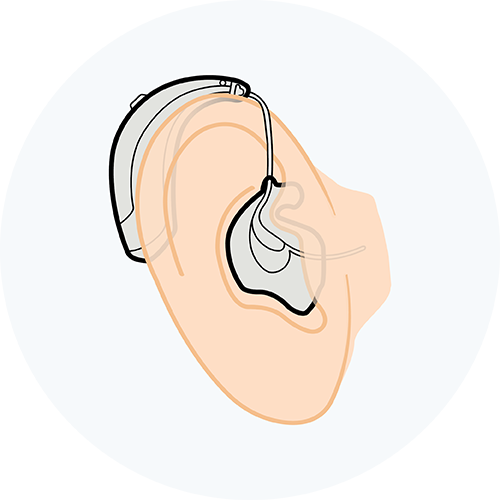
This device sits behind your ear and includes a plastic tube that hooks over your ear to reach the ear canal. A dome or custom-fit ear mold sits snugly within the canal at the end of the tube.
These devices tend to be larger than in-the-ear or in-the-canal hearing aids. Still, they can offer more capabilities, such as directional microphones, Bluetooth streaming, and a telecoil, which can help you hear better on the telephone and with assisted listening devices. They’re also easier to handle and can be a better choice for people with severe or profound hearing loss because there’s plenty of space in the casing for a larger receiver.
Of the brands and models covered in this review, the following companies offer BTE hearing aids:
- Lexie
- MDHearing
- Phonak
- hear.com
Receiver-in-canal (RIC) hearing aid
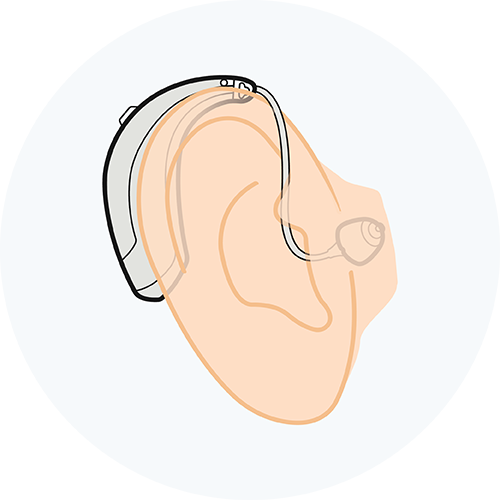
Also referred to as receiver-in-the-ear (RITE) or mini behind-the-ear (mBTE), RIC devices sit behind the ear like traditional types but are smaller and less visible, especially when you choose one that matches your hair color. They have a tiny wire encased in silicone tubing that hooks over the ear and connects to a small receiver that fits inside the ear canal.
These devices strike the perfect balance between looks and functionality for many users.
Of the brands and models covered in this review, the following companies offer RIC hearing aids:
- Jabra Enhance
- Lexie
- MDHearing
- Phonak
- ReSound
- hear.com
- Audicus
In-the-ear (ITE) hearing aid
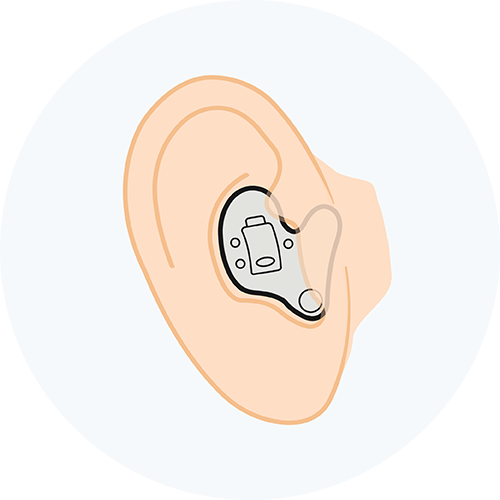
This type of hearing aid sits completely within the ear but is larger than the CIC style. ITE hearing aids are generally large enough to offer advanced features such as Bluetooth, directional microphones, and a telecoil, but the smaller size may limit their power compared to BTE models. ITE hearing aids are typically easier to handle and insert than their smaller counterparts, but they may also be more visible.
Of the brands and models covered in this review, the following companies offer ITE hearing aids:
- Audien
- hear.com

Which is better: In-the-ear or behind-the-ear hearing aids?
The choice between in-the-ear and behind-the-ear hearing aids depends on your individual needs and preferences. Behind-the-ear hearing aids are generally larger and more durable, with longer battery life and more features. They are suitable for all ages and hearing loss levels. In-the-ear hearing aids offer a smaller, more discreet option, often with telecoil compatibility for improved hearing in certain settings.
In-the-canal (ITC) hearing aid
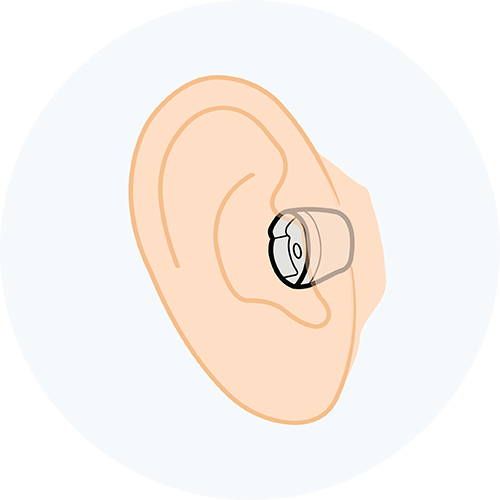
In-the-canal hearing aids sit deep in the ear canal but are larger and more visible than a CIC device. ITC hearing aids allow for longer battery life than many CIC devices and directional microphones. But they are still susceptible to issues with earwax and moisture, and they may be difficult for some people to handle due to their relatively small size.
Completely-in-the-canal (CIC) hearing aid

Also called a mini CIC, this hearing aid is the smallest and least visible device for treating hearing loss. It is positioned completely within the ear canal, and a tiny string allows you to remove the device.
In addition to an invisible fit, CIC devices offer the advantage of less feedback when using a telephone and less disruptive noise from the wind.
Due to their small size, CIC hearing aids may not have some features you’d get with other larger devices, such as Bluetooth streaming. Some CIC hearing aids are also too small for a directional microphone. Battery life may also be shorter due to the device’s small size, and ear wax and moisture can affect their function.
Of the brands and models covered in this review, the following companies offer CIC hearing aids:
- Eargo
- MDHearing
- Signia
- hear.com
- Audicus
Invisible-in-canal (IIC) hearing aid
One subtype of CIC hearing aid is the invisible-in-canal (IIC) style. The Phonak Lyric comes in this style. Sitting deep in the second bend of the ear canal, IIC hearing aids are truly invisible when properly inserted. They usually require disposable batteries.
Over-the-counter (OTC) hearing aids
In October 2022, the FDA established a new category of hearing aids, OTC hearing aids. As a result, consumers can now purchase certain hearing aids directly from pharmacies, stores, and online retailers—with no doctor visit or prescription required.
Based on the FDA’s final rule, [5]Federal Register. Medical Devices; Ear, Nose, and Throat Devices; Establishing Over-the-Counter Hearing Aids. Found on the internet at https://www.federalregister.gov/documents/2022/08/17/2022-17230/medical-devices-ear-nose-and-throat-devices-establishing-over-the-counter-hearing-aids OTC hearing aids:
- Are “intended to address perceived mild to moderate hearing loss in adults age 18 or older” [6]OTC Hearing Aids: What You Should Know. U.S. Food & Drug Administration. May 3, 2023. Found on the internet at https://www.fda.gov/medical-devices/hearing-aids/otc-hearing-aids-what-you-should-know
- Can be purchased online or in stores without a hearing exam, prescription, or professional fitting
The FDA’s final ruling on OTC hearing aids is meant to increase access. [7]Federal Register. Medical Devices; Ear, Nose, and Throat Devices; Establishing Over-the-Counter Hearing Aids. Found on the internet at https://www.federalregister.gov/documents/2022/08/17/2022-17230/medical-devices-ear-nose-and-throat-devices-establishing-over-the-counter-hearing-aids The high price of hearing aids, the perceived stigma of wearing them, and the concern that they aren’t effective are all common reasons that people with hearing loss wait an average of 10 years before seeking treatment. [8]Smith D, et al. Acceptability, benefits and costs of early screening for hearing disability: a study of potential screening tests and models. Found on the internet at https://www.journalslibrary.nihr.ac.uk/hta/hta11420/#/full-report This has paved the way for more retailers to enter the hearing aid market, which should drive the price down, making them affordable and shortening the wait time before people decide to treat their hearing loss.
Pros and cons of OTC hearing aids
If you’re not sure whether OTC hearing aids are right for you, it’s important to weigh the pros and cons. This can help you make the most informed decision when it comes to treating your hearing loss.
Pros and cons of prescription hearing aids
What to consider before buying a hearing aid
The National Institute on Deafness and Other Communication Disorders (NIDCD) reports that 37.5 million American adults have some level of hearing loss. [9]National Institute on Deafness and Other Communication Disorders. Quick Statistics About Hearing. Found on the internet at https://www.nidcd.nih.gov/health/statistics/quick-statistics-hearing While hearing loss can occur at any time in life, the problem becomes more common with age.
The NIDCD estimates almost one in four adults between the ages of 65 and 74 and half of people older than 75 have disabling hearing loss. So it may come as a surprise that only one in three adults who could benefit from hearing aids has ever used them.National Institute on Deafness and Other Communication Disorders. Quick Statistics About Hearing. Found on the internet at https://www.nidcd.nih.gov/health/statistics/quick-statistics-hearing
People with hearing loss may not seek help for a variety of reasons, including:
- The cost of hearing aids and hearing care
- The fact that some insurance companies and Medicare plans do not cover hearing aids
- Distance from hearing care providers
- The stigma associated with wearing a hearing aid [10]The Gerontologist. The Stigma of Hearing Loss. Found on the internet at https://academic.oup.com/gerontologist/article/50/1/66/692298
We asked Michelle Brady, an audiologist with Access Audiology, a mobile audiology service in the New York City area, what she’d like people to know about the purchasing process. According to Brady, the most important thing to consider when shopping for a hearing aid is time.
“Research has shown that the longer hearing loss goes untreated, the [more the] brain’s ability to understand and decode speech decreases,” Brady said. “Just like muscles in the body—if you don’t use it, you lose it. Unfortunately, hearing aids cannot override the damage that occurs from years of decreased auditory stimulation. The earlier a patient gets hearing aids and wears them consistently, the better their brain will be able to process and decode speech.”
Hearing loss has also been associated with higher rates of falls, depression, and social isolation among older adults. Getting your hearing checked and corrected can play an important role in improving your quality of life.
What older adults look for in hearing aids
Older adults concerned with the visibility of a hearing aid should consider in-the-ear (ITE) models that are more discreet compared to behind-the-ear (BTE) options. Additionally, if you are not particularly tech-savvy or just want a hearing aid that has the easiest setup, it might be beneficial to consider a more basic hearing aid device without too many complex features. On the other hand, if you’re comfortable with smartphones, apps, and customizing your own settings, a more advanced model does offer more overall convenience in terms of operations.
Hearing aid features to consider
As hearing aid technology changes, more features become available. The following are a few of the most popular additional features that can make your hearing aids more helpful and enjoyable to use.
| Feature | Description |
|---|---|
| Bluetooth capabilities | When your smartphone is paired with your hearing aids using wireless Bluetooth technology, you can stream calls and audio from your phone or other device to your hearing aids. Bluetooth is a wireless technology that allows the exchange of information or data, in this case sound, between different devices. Smartphones have Bluetooth capability. Hearing devices with this feature can also connect to smartphone apps, allowing you to use your phone to adjust your hearing aid sound settings. |
| Directional microphones | Directional microphones help you understand conversations in noisy environments by making the sound in front of you louder than the sound coming from the rear or sides. Directional microphones work best when you are close to the sound source. |
| Feedback suppression | Feedback suppression in hearing aids helps to reduce high-pitched whistling sounds. It’s useful for minimizing feedback if you’re close to the telephone or if the hearing aid becomes slightly dislodged from your ear when you move your jaw. It can also allow for better sound quality for listeners who have good hearing in the lowest frequencies. |
| Digital noise reduction | Digital noise reduction improves listening performance in noisy environments by blocking out some background noise, making it easier to hear and understand speech. A majority of respondents to our survey said that digital noise reduction was the most important feature they wanted in a hearing aid. |
| Tinnitus masking | Hearing aids with a tinnitus masking feature minimize the ringing or buzzing sounds common in tinnitus by playing a variety of tones to help distract the brain. |
| Rechargeable batteries | Rechargeable hearing aid batteries allow you to recharge your devices instead of regularly buying new batteries and replacing them. The batteries don’t need to be removed from the hearing aids in order to charge them—you can place both hearing aids in a charging dock at night so they’re charged and ready to go in the morning. |
| Telecoil | A telecoil improves the ability to hear on telephones equipped with assistive listening technology and in facilities fitted with hearing loops. Most types of hearing aids have the telecoil option available. But due to their small size, CIC and IIC devices do not come with a telecoil. |
| Amplified Frequencies | Amplified frequencies directly impact your ability to hear specific sounds. Hearing aids are designed to amplify sounds at different frequencies, and it’s essential to select a device that targets the frequencies where your hearing loss is most pronounced. This information is typically available in user manuals. |
| AI Features | AI algorithms help hearing aids adapt to specific environments, which can improve their functionality for a better listening experience. AI can also analyze self-reported data and audiograms for helpful feedback and recommendations. |
Common types of hearing loss
The type of hearing loss you have could influence the type of hearing aid you decide to purchase. Read on for information on the most common types of hearing loss. [11]Centers for Disease Control and Prevention. Understanding Hearing Loss. Aug. 7, 2023. Found on the internet at https://www.cdc.gov/ncbddd/hearingloss/parentsguide/understanding/understandinghearingloss.html
- High frequency: Trouble hearing sounds in the 2,000–8,000 hertz (Hz) range, which are many of the sounds involved in speech (most people with age-related hearing loss have problems hearing high frequencies.) This type of hearing loss can make it difficult to hear sounds like “s,” “f,” “t,” and “th,” as well as the vowels “e,” “i,” and “y.” Women’s and children’s voices often fall in this range.
- Low frequency: Difficulty hearing sound frequencies of 2,000 Hz or lower. Lower-frequency hearing loss can affect the perception of sounds like “b,” “d,” “g,” and the vowels “a,” “o,” and “u.” Men’s voices also tend to fall in this range.
- Sensorineural: This is the most common type of age-related hearing loss and is caused by damage to the auditory nerve or hair cells in the inner ear
- Conductive: Caused by a problem with sound traveling through the outer or middle ear
- Presbycusis: Presbycusis is the gradual loss of hearing that occurs as we age
- Mixed: A combination of sensorineural and conductive hearing loss
Degrees of hearing loss
Your degree of hearing loss can also impact the style of hearing aid that suits your needs. The CDC outlines four levels, or degrees, of hearing loss based on how loud sounds must be for you to hear and understand them. [11]
- Mild (26 dB to 40 dB): Able to hear some speech, but softer sounds are difficult to hear. Those with mild hearing loss may struggle with softer sounds, such as consonants like “s,” “f,” “t,” and “th,” as well as certain vowels like “i.”
- Moderate (41 dB to 55 dB): Unable to hear most speech at a normal level. With moderate hearing loss, sounds like “n,” “e,” and “u” become harder to hear.
- Severe (56 dB to 90 dB): Unable to hear speech at all. Those with severe hearing loss can only hear some loud sounds.
- Profound (91+ dB): Profound hearing loss means you are only able to hear extremely loud sounds.
Centers for Disease Control and Prevention. Understanding Hearing Loss. Aug. 7, 2023. Found on the internet at https://www.cdc.gov/ncbddd/hearingloss/parentsguide/understanding/understandinghearingloss.htmlFor mild hearing loss, devices like the Jabra Enhance or Eargo are ideal due to their discreet and comfortable design. Those with moderate hearing loss might prefer the MD Hearing or Lexie, which offer more power and advanced features.
For severe to profound hearing loss, Phonak or Resound hearing aids provide advanced amplification and technology to significantly improve hearing and speech understanding.
Hearing aids and tinnitus
Tinnitus is a common condition in which people hear sounds even when no external noise is present. Individuals may experience tinnitus as ringing, whistling, buzzing, or hissing sounds, which may be constant or intermittent. People experiencing hearing loss commonly have tinnitus, resulting from various underlying causes, including exposure to loud noises, ear infections, and age-related auditory decline.
Hearing aids can help you manage tinnitus symptoms, especially when it occurs alongside hearing loss. By amplifying external sounds, hearing aids can make the internal sounds of tinnitus less noticeable, relieving the user. Some hearing aids also have specialized tinnitus masking features that introduce soothing tones or white noise to help distract from the tinnitus sounds. For more information and to explore options tailored to managing tinnitus, visit hearing aids for tinnitus.
How much do hearing aids cost?
The cost of hearing aids largely depends on whether you’re purchasing OTC or prescription hearing aids, as well as the battery type (disposable or rechargeable), features, and sound technology. In fact, hearing aid pricing ranges widely: from $99 to $7,000.
How to find affordable hearing aids
Hearing aids are an investment. Even the most inexpensive hearing aids cost around $300 per pair.
MDHearing, for example, sells budget-friendly digital hearing aids starting at $999.98 per pair (before promotions). Audien offers low-cost devices starting at $99 per pair, but they’re very basic compared to other hearing aids on the market.
Before buying a lower-cost model, make sure to check the fine print. Some retailers and online distributors advertise low-cost hearing aids but are actually selling PSAPs, which amplify sound but do not provide the same level of support or technology as a hearing aid.
Hearing aids are typically sold through hearing care clinics or larger retailers, like Walmart or Costco. But you can also find inexpensive OTC hearing aids online through companies like MDHearing, Jabra Enhance, Lexie, and Eargo.
If you need a prescription hearing aid that’s only offered through a hearing care clinic, consider purchasing through an authorized discount supplier, such as Yes Hearing, which sells high-quality hearing aids, like Phonak and Signia, at a reduced cost. You still work with a local audiologist to get fitted and set up with your device, while the supplier manages the purchasing process with your hearing provider. This option could save you hundreds of dollars.
Read our review of the best affordable hearing aids for more in-depth guidance.
Does Medicare or insurance cover hearing aids?
Medicare Parts A and B don’t include coverage for hearing aids, although many Medicare Advantage Plans (known as Part C) and private insurance plans do provide hearing benefits. Contact your health care provider for more information.
NCOA continues to advocate for Medicare coverage of hearing aids by working with Medicare beneficiary groups and supporting H.R. 5376, the Build Back Better Act, which would initiate Medicare coverage for hearing aids.
In January 2023, U.S. representatives Debbie Dingell (D-MI) and Brian Fitzpatrick (R-PA) also reintroduced H.R. 244, the Medicare Hearing Aid Coverage Act, to Congress. Our team spoke with Rep. Dingell’s office and learned that if the bill passes, it would remove a Social Security restriction on hearing aid coverage.

“Hearing aids aren’t a luxury, they are critical for millions of people to maintain a healthy, independent lifestyle. Without them, many seniors cannot interact with family, friends, neighbors, and their communities, and as a result, can become isolated.
“By expanding coverage for hearing aids under Medicare, more seniors will be able to live with dignity and independence. I’m proud to re-introduce this legislation, and remain committed to getting this signed into law to expand access to care for so many who need it. It’s simple: No one should feel isolated, confused, or shut out from the world because they can’t afford hearing aids,” said Dingell.
How to buy hearing aids
A few years ago, there was only one way to get treatment for hearing loss: Make a trip to a hearing care clinic to be tested and fitted for hearing aids. This was a challenge for many people who didn’t have easy access to these locations. But thanks to recent changes in the hearing aids industry, there are now multiple ways to purchase high-quality hearing aids.
Visit a hearing clinic
For prescription hearing aids, you will generally need to visit a hearing care clinic for an in-person consultation and hearing exam by an audiologist or hearing instrument specialist. Audiologists are hearing professionals with at least a master’s degree in the field of audiology who diagnose hearing loss and fit hearing aids. Hearing instrument specialists are hearing professionals with a high school diploma or two-year degree and are only licensed to help fit or program hearing aids.
Purchase prescription hearing aids through a discount network
Another option is to purchase prescription hearing aids from a discount network such as Yes Hearing for up to 40% less than retail price. When you purchase through this network, you’ll be connected with an audiologist in your area for further care. If you are a veteran, check with your local Veteran Affairs (VA) medical center about meeting with an audiologist, getting a hearing test, and determining which hearing aid is right for you.
Larger retail stores, such as Costco, also sell hearing aids. Almost 15% of the hearing aid users we surveyed used Kirkland hearing aids from Costco. The next most popular brand in our survey was Eargo, with 8%.

Understanding prescription hearing aid abbreviations
Each hearing aid company may have its own naming conventions. However, here are some common hearing aid abbreviations and their meanings:
- D = Disposable battery
- R = Rechargeable battery
- T = Telecoil
- S = Standard receiver (for mild hearing loss)
- M = Moderate receiver (for moderate hearing loss)
- P = Power receiver (for severe hearing loss)
- UP = Ultra Power receiver (for profound hearing loss)
Buying OTC hearing aids online
The ability to buy online hearing aids eliminates some of the barriers that can prevent people from seeking care for their hearing loss. Overall, the purchasing process is simple for many OTC hearing aids, but it’s important to know that buying hearing aids online isn’t for everyone.
In some cases, hearing loss may be caused by a medical problem such as diabetes, osteoporosis, or meningitis, and that can only be detected in a consultation with a medical doctor and an audiologist. Buying hearing aids without that intervention may allow an underlying medical problem to persist.
It’s also important to keep in mind that getting the right hearing aid for your needs depends on your specific type and severity of hearing loss. Hearing aids bought through a hearing clinic are programmed individually for each person according to the results of their audiogram (hearing test).
In-person vs. online hearing screenings
In-person hearing tests are much more detailed than online hearing screenings, because they include a physical exam of the ear and several tests to measure your ability to hear and understand various frequencies of speech and sound. Some OTC hearing aid companies, such as Jabra Enhance and Audicus, have an audiology team to interpret audiograms and program hearing aids, but others don’t.
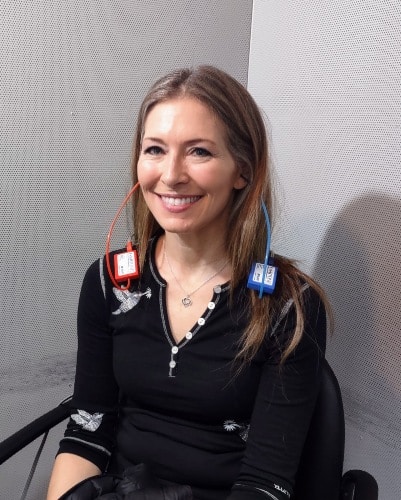
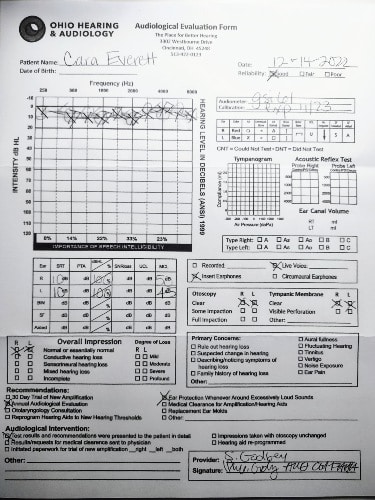
Keep in mind that some of the less expensive devices don’t have the detailed programming options necessary for many types of hearing loss. These include certain OTC hearing aids (including Audien) as well as personal sound amplification products (PSAPs), which are not true hearing aids. PSAPs make all sounds louder, but they aren’t able to target the specific frequencies where hearing loss has occurred or filter out background noise.
If you aren’t sure what type of hearing aid you need, speak with an audiologist or hearing aid specialist who can provide guidance.
Buying OTC hearing aids
As mentioned above, many stores that carry health devices also sell OTC hearing aids. Check the list below to see if any of the following retail stores are in your area:
- Best Buy
- CVS
- Walgreens
- Walmart
- Victra Verizon
You can also purchase hearing aids online from companies that offer quality OTC hearing devices at lower prices. Some OTC hearing aid manufacturers provide virtual consultations with an audiologist for personalized recommendations and adjustments along with your purchase.
What to expect when you first get hearing aids
Adjusting to new hearing aids often takes time. Here’s what you might experience during the initial adjustment periods:
- Sound sensitivity: It will take your ears some time to warm up to your hearing aids, especially if you’ve had hearing loss for a while.
- Tinnitus: Some people experience a temporary increase in tinnitus when they first start wearing hearing aids. Often, this is due to an increased awareness of sounds.
- Difficulty understanding speech: It will take some time to adjust to the different sounds and accents that hearing aids amplify, even if you haven’t had hearing loss for very long.
- Discomfort: Hearing aids may feel a little uncomfortable at first. It can take some getting used to.
How to care for your hearing aids
Maintaining and taking care of your hearing aids will ensure they function properly and have a long battery life. You should clean your devices regularly, according to the manufacturer’s instructions, as substances like ear wax and fluids, including ear drainage, can cause damage to your hearing aids. You should also avoid moisture (especially if your devices are not water resistant), as well as high temperatures. It’s also best to remove your hearing aids when using hair products. When it comes to battery life, make sure you change disposable batteries as soon as they die and turn off your hearing aids whenever they are not in use.
To ensure your hearing aids function properly and last a long time, remember to:
- Clean the wax filters regularly using a soft-bristled brush
- Inspect and replace ear domes as needed to maintain a comfortable fit
- Wipe down your hearing aids daily with a soft, dry cloth to remove dirt and moisture
- Remove hearing aids before showering, bathing, or swimming unless they are water-resistant
- Replace disposable batteries quickly to avoid straining the device
- Avoid using harsh chemicals to clean your hearing aids
The future of hearing aids
With so many advances in technology, it’s no surprise the future of hearing aids is especially bright. Manufacturers continue to innovate to offer consumers the best hearing solutions possible through state-of-the-art sound technology.
Newest hearing aid technology in 2025
According to the National Institute on Deafness and Other Communication Disorders, researchers are heavily invested in learning how to apply new signal processing tactics to hearing aids. Additionally, computer-aided technology systems are being utilized to improve design components. New ideations surrounding improved sound transmission and reduced background noise are also underway [13], as are advancements in enhanced Bluetooth connectivity, rechargeable batteries, and telehealth capabilities for remote adjustments and fittings.National Institute on Deafness and Other Communication Disorders. Hearing Aids. Oct. 11, 2022. Found on the internet at https://www.nidcd.nih.gov/health/hearing-aids
Still, studies focused on how to choose and fit hearing aids for certain groups of people, including children, are in the works, with scientists running directional microphone tests on the ear structure of a tiny fly.
Additionally, the use of Bluetooth connectivity continues to advance with major hearing aid makers because it improves our daily quality of life. Some of the best Bluetooth hearing aids offer multi-device streaming and connectivity so you can switch seamlessly from your smartphone to your television. It won’t be long before more brands implement better Bluetooth features, too. With Bluetooth and smartphones top of mind, we can expect a more upgraded smartphone app experience as well.
Auracast is a revolutionary new technology allowing simultaneous broadcasting from multiple devices. Traditional Bluetooth connections are limited to a single device. With Auracast, multiple users can listen to the same audio stream at the same time. This technology allows you to share your favorite music or podcasts with friends and families or even listen to public broadcasts directly through your hearing aids.
Plus, well-known hearing aid brands, like Oticon and Widex, are already using artificial intelligence (AI) features for auto-adjustment, user inputs, and to power natural sound. And it won’t be a surprise if big brand collaborations are in store from household names, like Apple and Samsung, which are already extremely sound-oriented.
The rise in popularity of telehealth services now includes hearing health care, too. When it comes to methods of shopping for hearing aids, we expect more companies to begin offering full-service in-home prescription hearing aids to consumers, with models similar to hear.com.
Hearing aids and health
We know that hearing aids improve the health of users by improving their hearing, but research also suggests that mitigating hearing loss can improve the overall health of older adults.
The National Institutes of Health’s news publication, NIH Research Matters, [16] NIH Research Matters. Hearing aids slow cognitive decline in people at high risk. Found on the internet at: https://www.nih.gov/news-events/nih-research-matters/hearing-aids-slow-cognitive-decline-people-high-risk reports on the connection between cognitive decline and hearing loss in a new study looking at the connection between hearing aids and slowing cognitive decline. While no significant difference was found in cognitive decline between those who did and did not receive hearing aids when they analyzed the entire population of study participants, a 50% decrease in cognitive decline was seen in those who were at a higher risk of cognitive decline and received a hearing aid.
Falls-related injuries pose a significant health risk for older adults, who are 2.4 times more likely to experience falls if they have hearing loss, according to the Journal of The American Geriatrics Society. In their research, however, they found that consistent use of hearing aids is associated with a 50% decrease in falls compared to those who don’t consistently use hearing aids.
We also witness a connection between hearing loss and mental health. It’s normal to experience feelings of social isolation or anxiety about communication if your hearing has changed over time, but isolation and communication difficulties can contribute to depression and anxiety. Seeing a doctor about hearing loss, and using hearing aids to improve hearing, can help to mitigate mental health symptoms in those experiencing hearing loss.
Frequently asked questions
There are five main types of hearing aids:
- Completely-in-canal (CIC): The smallest type, CIC devices sit completely within the ear canal, with a tiny string that hangs outside your ear so you can remove them easily.
- In-the-canal (ITC): These devices also sit in the ear canal, but are larger and a bit more visible than CICs.
- Behind-the-ear (BTE): BTE devices have an earmold that rests behind your ear, with a plastic tube that hooks over your ear and runs into your ear canal to transmit amplified sound.
- Receiver-in-canal (RIC): RIC devices, also known as receiver-in-the-ear (RITE) or mini behind-the-ear (mBTE), sit behind the ear like the BTE type, but are often smaller and less visible.
- In-the-ear (ITE): ITE devices sit completely within the ear like the CIC, but are larger, making them easier to handle but more visible.
- Jabra Enhance: Jabra Enhance is a popular choice due to its user-friendly technology and robust customer service.
- Audien: These affordable hearing aids are appreciated for their compact design and sound technology.
- Eargo: Eargo hearing aids are highly regarded for their virtually invisible design and customizable sound settings.
- Lexie: These OTC hearing aids are notable for their user-friendliness and customizable settings.
- Phonak: Phonak is renowned for its cutting-edge technology and extensive range of hearing solutions.
Crackling, or static noise in your hearing aids, usually signals that your devices need maintenance—the battery may be low or there could be a buildup of moisture, earwax, or dirt in your hearing aid. When you hear a crackling, first try repositioning your hearing aids. If that doesn’t work, flush your ear canal with an earwax remover and clean your hearing aids thoroughly. If the problem persists, go to a hearing clinic or contact your device manufacturer for assistance.
Unless a doctor or audiologist has recommended hearing aids, you may not know if you need them. But if you’re noticing that you have trouble hearing in one or both ears, it may be time to consider hearing aids. Your spouse, other family members, and/or friends may have also noticed your difficulties with hearing and recommended hearing aids as a solution.
Some signs of hearing loss to be aware of, according to the Mayo Clinic, include: [14]Mayo Clinic. Hearing Loss. Found on the internet at https://www.mayoclinic.org/diseases-conditions/hearing-loss/symptoms-causes/syc-20373072
- Feeling the need to speak loudly
- Requiring audio devices to be turned up louder than normal
- Asking people to repeat themselves because you can’t hear or understand them
- Straining to hear
- Hearing better out of one ear
- Having difficulty hearing people on the phone
- Noticing that certain sounds and voices are muffled
If you’re experiencing any signs or symptoms of hearing loss, consider seeing an audiologist or hearing specialist. They can conduct a hearing exam to determine the degree of your hearing loss and provide a recommendation for different hearing aid styles and brands.
Even the most advanced hearing aids will not completely restore your hearing to its previous level. Instead, hearing aids are designed to maximize your hearing potential, especially in challenging listening situations.
Although they serve as an excellent tool to help retrain your brain to interpret sounds and filter others out, hearing aids can’t totally restore your hearing.
Hearing aids either use a rechargeable battery that comes with the hearing aid or a standard disposable battery. If the hearing aids use disposable batteries, make a note of the size. In general, standard hearing aid batteries come in four sizes: 10, 13, 312, and 675. You can purchase hearing aid batteries at pharmacies, retail stores, or directly from the hearing aid company.
Most rechargeable batteries are unique to the hearing aid. If you need a new rechargeable battery or charger, buy it directly from your hearing aid company.
You can have hearing loss in one or both ears. But most people have hearing loss in both ears. If you are in this category, experts recommend that you wear bilateral hearing aids—one in your left ear and one in your right ear. [15]Harvard Health Publishing. One Hearing Aid or Two? Found on the internet at https://www.health.harvard.edu/diseases-and-conditions/one-hearing-aid-or-two
Your brain receives signals from both ears, so it’s easier to process the noise into sound if it is getting information from both ears. However, many hearing aids can be programmed separately to accommodate the loss in each ear.
In-the-ear (ITE) hearing aids are custom-made devices designed to fit inside the ear, either partially or completely, and are suitable for individuals with mild to severe hearing loss. These hearing aid styles are less bulky than behind-the-ear (BTE) styles, but still larger and more noticeable than completely-in-the-canal (CIC) hearing aids.
While ITE devices are generally easier to insert, handle, and control than CIC styles, they do require an adjustment period. Some people experience discomfort during the first few weeks of use, often because they are new to wearing hearing aids, but also because they’ve become accustomed to the way other hearing aid styles feel in their ears, especially BTE styles. With time, most people find ITE styles comfortable and easy to wear.
In-the-ear hearing aids may come with a larger variety of features than smaller, nearly invisible devices are able to provide because they have more room for technology inside their casings, like telecoil for enhanced sound during phone conversations and public events. But they also have some drawbacks. ITEs may require more frequent cleaning due to earwax buildup, and are more prone to feedback issues than some models. ITE styles are not recommended for young children or those with profound hearing loss.
Adjusting to your new hearing aids takes time. For some people, getting used to wearing hearing aids happens within a few days. For others, there is an adjustment period that may take a few months.
In general, you should notice a difference right away. If you’re having problems, contact the hearing center or online retailer that sold you the hearing aids. They can provide tips and guidance to help with the fit and improve your hearing aid experience.
All hearing aids work to some degree. The style, size, and features determine how well they work for each type of hearing loss.
The advantage of small hearing aids is the almost invisible appearance they provide. Research shows that many people, especially older adults, associate hearing loss and hearing aids with stigma related to perceived feelings of lower cognitive ability, ageism (that hearing aids or hearing loss make them feel older), and vanity (that hearing aids or hearing loss make them look older).
Because they go in your ear, smaller hearing aids may not be a good fit for everyone’s ear canal. That’s why it’s a good idea to go to a professional to get fitted. Small hearing aids may also require more battery changes since they can only hold a small battery, and the compact size may result in fewer features.
If you buy one single hearing aid, the average cost is about $2,300, with the full range at $1,000–$4,000. For more severe hearing loss, the price of one hearing aid can cost up to $6,000.
Hearing aids are a substantial investment, and finding an affordable hearing device is a high priority for many people. Most companies offer several models at different prices.
If you’re looking for a hearing aid brand that consistently sells lower-priced products, MDHearing and Audien are both great places to start. In general, MDHearing devices range in price from $200–$800 for a single hearing aid and $400–$1,000 per pair. Audien carries even lower-priced hearing devices, ranging from $99–$249 per pair.
Visit NCOA’s Hearing Health page for more resources on hearing health for older adults.
The best hearing aids are those customized to your specific hearing loss, lifestyle, and preferences. Consulting with a hearing care professional, like an audiologist, is crucial to assess your hearing and recommend suitable options that are within your budget.
Consider your daily environment, occupation, and desired features. The right hearing aid should fit comfortably enough to wear all day. Ultimately, the best hearing aid is one you’re willing to wear consistently, enhancing your daily life without discomfort.
On average, hearing aids last about three to seven years. How well you maintain your hearing aids will impact their lifespan, but it also depends on their construction and how much wear and tear they experience from being worn each day.
Adjusting to hearing aids takes patience. The transition can take a few days to several months, so give yourself time to adapt, and visit your hearing-care professional for adjustments as needed. It’s important to remember that hearing aids aren’t able to restore your hearing to its original state but to enhance it. Hearing professionals advise users to wear their hearing aids as often as possible and in different settings, whether watching TV at home, walking in the neighborhood, or dining in a busy restaurant, to help your brain readjust to the sounds it was missing.
If you find the adjustment period challenging, schedule a follow-up with your hearing specialist. They can tweak your device settings or suggest a different style that better suits your needs. Remember, even a minor adjustment to your hearing aids can make a significant difference in comfort and performance.
Costco hearing aids are often more affordable than other retailers due to Costco’s business model. They can offer lower prices by buying hearing aids in bulk directly from manufacturers. Costco then sells hearing aids to members at a discounted rate. Learn more about the best Costco hearing aids, including features and pricing.
Phonak hearing aids are highly recommended for speech clarity due to advanced sound processing technology and adaptive microphones, which enhance speech understanding in various environments.
The most comfortable hearing aids are typically lightweight, have a discreet design, and use soft, flexible materials that conform to the shape of the ear. Look for features like customizable ear tips and adjustable settings for a personalized fit that also enhances comfort for extended wear.
Have questions about this review? Email us at reviewsteam@ncoa.org.
Sources
- Centers for Disease Control and Prevention. Facts About Falls. Found on the internet at https://www.cdc.gov/falls/about/index.html
- John Hopkins Medicine. Hearing Loss Linked to Three-Fold Risk of Falling. Feb. 27, 2012. Found on the internet at https://www.hopkinsmedicine.org/news/media/releases/hearing_loss_linked_to_three_fold_risk_of_falling
- Rock Health. Consumer Adoption of Digital Health in 2022: Moving at the Speed of Trust. Feb. 21, 2023. Found on the internet at https://rockhealth.com/insights/consumer-adoption-of-digital-health-in-2022-moving-at-the-speed-of-trust/
- U.S. Food and Drug Administration. Types of Hearing Aids. Found on the internet at https://www.fda.gov/medical-devices/hearing-aids/types-hearing-aids
- Federal Register. Medical Devices; Ear, Nose, and Throat Devices; Establishing Over-the-Counter Hearing Aids. Found on the internet at https://www.federalregister.gov/documents/2022/08/17/2022-17230/medical-devices-ear-nose-and-throat-devices-establishing-over-the-counter-hearing-aids
- OTC Hearing Aids: What You Should Know. U.S. Food & Drug Administration. May 3, 2023. Found on the internet at https://www.fda.gov/medical-devices/hearing-aids/otc-hearing-aids-what-you-should-know
- National Institute on Deafness and Other Communication Disorders. Over-the-Counter Hearing Aids. Found on the internet at https://www.nidcd.nih.gov/health/over-counter-hearing-aids
- Smith, D, et al. Acceptability, Benefits and Costs of Early Screening for Hearing Disability: A Study of Potential Screening Tests and Models. November 2007. Found on the internet at https://www.journalslibrary.nihr.ac.uk/hta/hta11420/#/full-report
- National Institute on Deafness and Other Communication Disorders. Quick Statistics About Hearing. Found on the internet at https://www.nidcd.nih.gov/health/statistics/quick-statistics-hearing
- Wallhagen, Margaret. The Stigma of Hearing Loss. The Gerontologist. February 2010. Found on the internet at https://academic.oup.com/gerontologist/article/50/1/66/692298
- Centers for Disease Control and Prevention. Understanding Hearing Loss. Aug. 7, 2023. Found on the internet at https://www.cdc.gov/ncbddd/hearingloss/parentsguide/understanding/understandinghearingloss.html
- Mayo Clinic. Hearing aids: How to choose the right one. Found on the internet at https://www.mayoclinic.org/diseases-conditions/hearing-loss/in-depth/hearing-aids/art-20044116
- National Institute on Deafness and Other Communication Disorders. Hearing Aids. Oct. 11, 2022. Found on the internet at https://www.nidcd.nih.gov/health/hearing-aids
- Mayo Clinic. Hearing Loss. Found on the internet at https://www.mayoclinic.org/diseases-conditions/hearing-loss/symptoms-causes/syc-20373072
- Harvard Health Publishing. One Hearing Aid or Two? Found on the internet at https://www.health.harvard.edu/diseases-and-conditions/one-hearing-aid-or-two
- Source: NIH Research Matters. Hearing aids slow cognitive decline in people at high risk. Found on the internet at: https://www.nih.gov/news-events/nih-research-matters/hearing-aids-slow-cognitive-decline-people-high-risk









